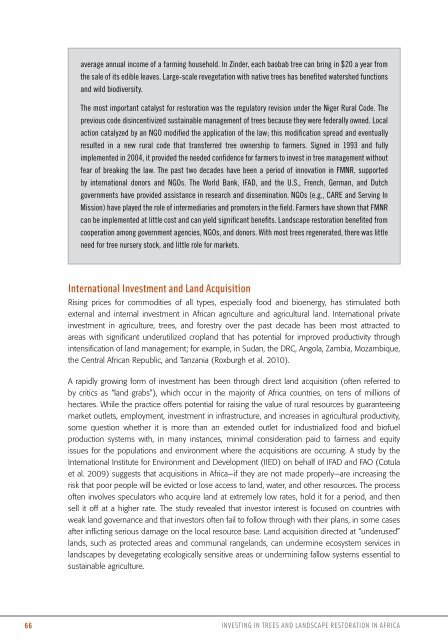INVESTING IN TREES AND LANDSCAPE ... - PROFOR
INVESTING IN TREES AND LANDSCAPE ... - PROFOR
INVESTING IN TREES AND LANDSCAPE ... - PROFOR
Create successful ePaper yourself
Turn your PDF publications into a flip-book with our unique Google optimized e-Paper software.
average annual income of a farming household. In Zinder, each baobab tree can bring in $20 a year from<br />
the sale of its edible leaves. Large-scale revegetation with native trees has benefited watershed functions<br />
and wild biodiversity.<br />
The most important catalyst for restoration was the regulatory revision under the Niger Rural Code. The<br />
previous code disincentivized sustainable management of trees because they were federally owned. Local<br />
action catalyzed by an NGO modified the application of the law; this modification spread and eventually<br />
resulted in a new rural code that transferred tree ownership to farmers. Signed in 1993 and fully<br />
implemented in 2004, it provided the needed confidence for farmers to invest in tree management without<br />
fear of breaking the law. The past two decades have been a period of innovation in FMNR, supported<br />
by international donors and NGOs. The World Bank, IFAD, and the U.S., French, German, and Dutch<br />
governments have provided assistance in research and dissemination. NGOs (e.g., CARE and Serving In<br />
Mission) have played the role of intermediaries and promoters in the field. Farmers have shown that FMNR<br />
can be implemented at little cost and can yield significant benefits. Landscape restoration benefited from<br />
cooperation among government agencies, NGOs, and donors. With most trees regenerated, there was little<br />
need for tree nursery stock, and little role for markets.<br />
International Investment and Land Acquisition<br />
Rising prices for commodities of all types, especially food and bioenergy, has stimulated both<br />
external and internal investment in African agriculture and agricultural land. International private<br />
investment in agriculture, trees, and forestry over the past decade has been most attracted to<br />
areas with significant underutilized cropland that has potential for improved productivity through<br />
intensification of land management; for example, in Sudan, the DRC, Angola, Zambia, Mozambique,<br />
the Central African Republic, and Tanzania (Roxburgh et al. 2010).<br />
A rapidly growing form of investment has been through direct land acquisition (often referred to<br />
by critics as “land grabs”), which occur in the majority of Africa countries, on tens of millions of<br />
hectares. While the practice offers potential for raising the value of rural resources by guaranteeing<br />
market outlets, employment, investment in infrastructure, and increases in agricultural productivity,<br />
some question whether it is more than an extended outlet for industrialized food and biofuel<br />
production systems with, in many instances, minimal consideration paid to fairness and equity<br />
issues for the populations and environment where the acquisitions are occurring. A study by the<br />
International Institute for Environment and Development (IIED) on behalf of IFAD and FAO (Cotula<br />
et al. 2009) suggests that acquisitions in Africa—if they are not made properly—are increasing the<br />
risk that poor people will be evicted or lose access to land, water, and other resources. The process<br />
often involves speculators who acquire land at extremely low rates, hold it for a period, and then<br />
sell it off at a higher rate. The study revealed that investor interest is focused on countries with<br />
weak land governance and that investors often fail to follow through with their plans, in some cases<br />
after inflicting serious damage on the local resource base. Land acquisition directed at “underused”<br />
lands, such as protected areas and communal rangelands, can undermine ecosystem services in<br />
landscapes by devegetating ecologically sensitive areas or undermining fallow systems essential to<br />
sustainable agriculture.<br />
66 <strong><strong>IN</strong>VEST<strong>IN</strong>G</strong> <strong>IN</strong> <strong>TREES</strong> <strong>AND</strong> L<strong>AND</strong>SCAPE RESTORATION <strong>IN</strong> AFRICA

















